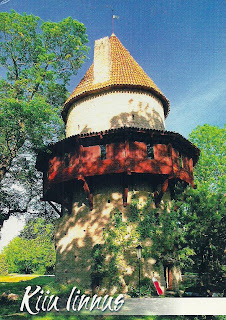 The third of the three postcards sent by SusaTiina from Estonia. This postcard shows a beautiful Old Town of Tallinn, a UNESCO World Heritage Site.
The third of the three postcards sent by SusaTiina from Estonia. This postcard shows a beautiful Old Town of Tallinn, a UNESCO World Heritage Site.
Tallinn is an outstanding and exceptionally complete and well-preserved example of a medieval northern European trading city. It retains the salient features of this unique form of economic and social community to a remarkable degree.
Archaeological investigations have shown that a fort on the limestone plateau of Toompea and a trading post and harbour at its foot, on the Viking route to Constantinople, have existed since the 10th-11th centuries. With the expansion of Baltic trade, the settlement known at that time as Lyndanise (Reval in German, Kolyvan in Russian) was occupied in 1219 by troops of Waldemar II of Denmark, who strengthened the fortifications on Toompea and built the first church.
After coming under direct papal jurisdiction in 1226-27, the town was divided into two parts: the fortress (castrum ) and the lower town (suburbum ). In 1230 the order invited 200 German merchants from Gotland to Tallinn, where they settled around a new church dedicated to St Nicholas, alongside the existing Estonian, Scandinavian and Russian trading posts. In 1248 Tallinn adopted the Lübeck statute, becoming a full member of the Hanseatic League in 1285. Its prosperity was reflected by its rapid growth in the 14th century: work began on the massive town wall in 1310, enclosing an area laid out according to the characteristic Baltic trading pattern with radiating streets. Along with the territory of northern Estonia, the town was sold to the Livonian Order, and it was the latter that was responsible for rebuilding the castle on Toompea as one of the strongest in the region.
With the fall of Visby in 1361 the importance of Tallinn increased substantially. The 15th century saw the transformation of the town, with the construction of a new town hall and other public buildings and the rebuilding of the merchants' wooden houses in stone. It was annexed by Sweden in 1561, and it was Swedish architects who were responsible for the reconstruction of the Toompea area after a disastrous fire in 1684 and for the addition of a system of bastions to the fortifications. In 1710 the town surrendered to the troops of Tsar Peter I, entering into a half-century of commercial and cultural stagnation, but this came to an end when its role as a provincial administrative centre was confirmed, with the castle as its seat. The town was heavily bombed in 1944. The church of St Nicholas and the area around it suffered grave damage.
The most prominent feature of the town is the Toompea limestone hill. The western part is occupied by the castle, of which the tower known as Long Hermann, two bastions and the imposing walls survive on the western, northern and eastern sides. Within the enceinte is the cathedral, which is basically Gothic but has been extended and reconstructed on a number of occasions since the Middle Ages.
The lower town preserves to a remarkable extent the medieval urban fabric of narrow winding streets, many of which retain their medieval names, and fine public and burgher buildings. The distribution of building plots survives virtually intact from the 13th-14th centuries.
Around the town hall (1371-1404) in Town Hall Square there are some exceptionally well-preserved burgher houses. These are high gabled structures in stone, the ground floors having been used for living quarters and the upper storeys as granaries and storehouses, many retaining their original projecting winch beams. An outstanding structure is the House of the Great Guild (1410), which is a splendid example of Northern Gothic with fine vaulted ceilings and richly decorated columns.
There are several medieval churches within the walls. The restored Church of St Nicholas (Niguliste) and the Church of St Olaf (Oleviste) are both in typical basilical form, with lofty vaulting and a precise geometry of form in what is recognized to be the distinctive Tallinn School. There are two monastic complexes surviving within the walls - the Dominican monastery of St Catherine and the Cistercian nunnery of St Michael, which was characteristically sited away from the main urban complex. (Source)








































